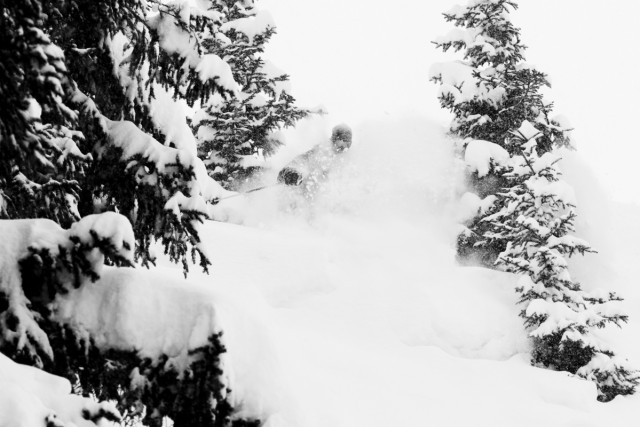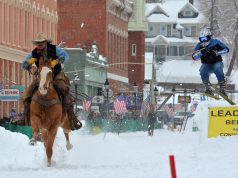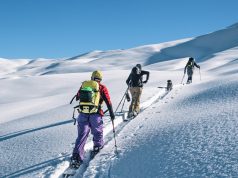
Powder is where you find it
The powder experience is arguably the best in skiing or snowboarding. Effortless turns, the sensation of weightlessness and the pure bliss of the untracked make powder the most sough tafter commodity on Colorado’s slopes.
And because of this, powder days are a rarity, as skiers flock to the slopes at the first whiff of a snowflake, looking to capture their own slice of bliss.
But while “powder days” at the big resorts — you know, the ski areas with the cheap season pass that you and all your friends bought — are becoming “powder mornings” with the snow tracked out by noon, there are still plenty of options for those addicted to deep snow bliss. And those options center around the so-called “Gems,” the marketing term coined by Colorado Ski Country USA to describe the state’s smaller resorts.
There are many benefits to checking out a “gem” or two this winter. The homegrown feel, lack of lift lines and more than affordable on-mountain restaurants are complemented by even cheaper apr%uFFFDs ski beers, lift tickets that won’t set you back a week’s paycheck and an on-mountain vibe that’s pure soul.
These ski areas are about skiing, nothing more and nothing less. But the
best thing about these mountains is that powder days are, truly, days,
with snow that stays untracked run after run after run.
Take
Monarch Mountain, for example. Perched at the top of the snow factory
called Monarch Pass, the ski area averages 350 inches of the deep stuff
per year. All that snow falls on 800 skiable acres, which on weekdays
are empty and aren’t much more crowded on weekends either. While Monarch
may lack the wide-open spaces of, say, Vail’s Back Bowls, the ski area
serves up a heaping helping of tree skiing, some of it hike-to (save
that terrain for later in the day if the main hill gets tracked out).
Although
small by Summit County standards, Monarch skis big, with multiple
aspects and ridges. At the end of the day, belly up to the bar in the
base lodge. The establishment is a home away from home for the locals,
who are quick to strike up a conversation and share tidbits of
knowledge, like how the top of the pass offers more great hike-to skiing
and car shuttle opportunities — backcountry terrain that perfectly
complements the inbounds stuff at Monarch.
Either way you look at it, the combination is a one-two punch that gives you more bang — and snow — for your buck.
Also
off the beaten path is the surprisingly steep and fun terrain of Ski
Sunlight. Given the proximity of Sunlight to the world-class charms of
Aspen, it’s easy to overlook this mountain, which sits in a hidden
valley above Glenwood Springs. With 470 acres served by three lifts, you
aren’t going to mistake Sunlight for its big brother up the road, but
if you want to taste the flavor of skiing in the Roaring Fork valley like it was back when Chair 1 was
the one and only chair on Aspen Mountain, Sunlight is the best place to
become a modern-day time traveler.
Sunlight
boasts one of the steepest runs in the state, The Heathen, an avalanche
chute that plunges through aspen groves and which clocks in at 52
degrees at its steepest point. This run, and the adjoining terrain, is
superlative on storm days, particularly mid-week when you’ll probably be
the only one there. Skiing through aspen trees is a Colorado classic,
and while the marketing folks at Steamboat hype the joys of their aspen
glades, that resort has nothing on Sunlight, where the terrain is
steeper and the snow stays untouched for much longer. Like Monarch,
Sunlight features a down-home bar in the base lodge. And while the
hardcore locals might sniff at the hot springs pool down in Glenwood,
since you’re not a local, it’s OK to play tourist and wrap up your day
on the mountain with a soak at this venerable spa. Book a room at the
Glenwood Hot Springs Lodge and make a weekend of it.
The
red rock desert landscapes surrounding Grand Junction seem an unlikely
backdrop for a ski resort, but those red rocks hide a secret known as
Powderhorn. Featuring 1,600 skiable acres served by four lifts, the ski
area is located on the Grand Mesa plateau, high above the moonscape that
surrounds Grand Junction. Powderhorn doesn’t attract too many
out-oftowners, but you can change that fact by heading west yourself.
The ski area’s proximity to the desert makes multi-sport weekends a
reality: this is the only ski area where you’d be advised to take your
mountain bike along with your skis, due to the nearby single track Mecca
of Fruita.
Spend a
day exploring the twin peaks of Powderhorn, hitting the powder stashes
off of Mudslide or Yoo Hoo and then mix it up the next day with some
riding on Prime Cut or Mary’s Loop outside of Fruita.
Finally,
there’s Loveland. During frigid January days, when the Continental
Divide is windswept and ugly, it’s easy to drive past Loveland to the
bigger resorts on the Western Slope. But in March and April, those cold
days give way to the warmth of spring, when the lateseason storms pound
the ski area, leaving in their wake crystal clear skies and untouched
snow. A mere 1.5 hours from Boulder, Loveland comes into its own during
the latter part of the season, especially in April, where it’s not
uncommon to enjoy two feet of snow in the morning and be able to soak up
the sun wearing a T-shirt at the base at the end of your day. Soak it
up because Loveland has one of the longest seasons in the state, and
once you’re finished there, the powder is probably also finished, too.
But don’t worry. The storms will be back next winter, when you can hit
the road again in search of your own private stash.
DETAILS
Monarch Ski Area:
skimonarch.com Ski Sunlight: sunlightmtn.com Glenwood Hot Springs Lodge:
hotspringspool.com Powderhorn Ski Area: powderhorn.com Fruita mountain
biking: gjmountainbiking.com
Respond: [email protected]














